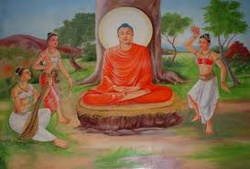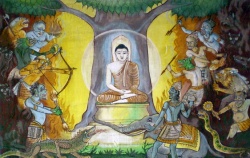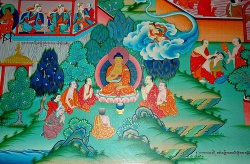Difference between revisions of "Buddhist Prophecies of the 21st Century and Beyond"
m (Text replacement - "Christianity" to "{{Wiki|Christianity}}") |
|||
| Line 4: | Line 4: | ||
| − | So far as I [[know]] there are two major [[Buddhist]] prophetic cycles that may be related to the 21st century: the 2,500 year mappo cycle and the [[Kalachakra]] prophecies. | + | So far as I [[know]] there are two major [[Buddhist]] prophetic cycles that may be related to the 21st century: the 2,500 year [[mappo]] cycle and the [[Kalachakra]] {{Wiki|prophecies}}. |
| − | The [[word]] mappo (more correctly, mofa) derives from the {{Wiki|Chinese}} [[末法]], meaning “the end of [[dharma]],” and refers to the last of three ages, commencing with the [[death]] of the [[Buddha]], estimated (according to current {{Wiki|scholarship}}) to correspond to the year 383 BCE or, in round numbers, 400 BCE. In the Mahasamnipata [[Sutra]], the three periods are further divided into five five-hundred year periods, the fifth and last of which was prophesied to be a [[time]] when the [[Buddhism]] of [[Sakyamuni]] would lose all [[power]] of salvation and a new [[Buddha]] would appear to save the [[people]]. The three periods and the five five-hundred year periods are also described in the [[Sutra]] of the Great Assembly. This [[time]] period would be characterized by unrest, strife, famine, and other natural disasters. The final millenium of this 2,500 year cycle represents the {{Wiki|nadir}} of the first 2,500 year cycle of historical [[Buddhism]], and the arising of a new current. Descriptions of the three periods also appear in other [[sutras]]. Since the [[Buddha]] [[died]] in 383 BCE, this means that the “new current” may be expected about 2100, corresponding very neatly both with the rise of the technological singularity and the appearance of [[Shambala]] according to the [[Kalachakra]]. | + | The [[word]] [[mappo]] (more correctly, [[mofa]]) derives from the {{Wiki|Chinese}} [[末法]], meaning “the end of [[dharma]],” and refers to the last of three ages, commencing with the [[death]] of the [[Buddha]], estimated (according to current {{Wiki|scholarship}}) to correspond to the year 383 BCE or, in round numbers, 400 BCE. In the Mahasamnipata [[Sutra]], the [[three periods]] are further divided into five five-hundred year periods, the fifth and last of which was prophesied to be a [[time]] when the [[Buddhism]] of [[Sakyamuni]] would lose all [[power]] of {{Wiki|salvation}} and a new [[Buddha]] would appear to save the [[people]]. The [[three periods]] and the five five-hundred year periods are also described in the [[Sutra]] of the [[Great Assembly]]. This [[time]] period would be characterized by unrest, strife, famine, and other natural {{Wiki|disasters}}. The final millenium of this 2,500 year cycle represents the {{Wiki|nadir}} of the first 2,500 year cycle of historical [[Buddhism]], and the [[arising]] of a new current. Descriptions of the [[three periods]] also appear in other [[sutras]]. Since the [[Buddha]] [[died]] in 383 BCE, this means that the “new current” may be expected about 2100, corresponding very neatly both with the rise of the technological [[singularity]] and the [[appearance]] of [[Shambala]] according to the [[Kalachakra]]. |
| − | If one looks at historical [[Buddhism]] in the [[light]] of this {{Wiki|theory}}, the following historical development may be seen: | + | If one looks at historical [[Buddhism]] in the [[light]] of this {{Wiki|theory}}, the following historical [[development]] may be seen: |
[[File:60.jpg|thumb|250px|]] | [[File:60.jpg|thumb|250px|]] | ||
400 BCE-100 CE: The [[death]] of the [[Buddha]] followed by the consolidation of the teachings in the [[Pali Canon]]; a period of establishment and consolidation; Outer [[Buddhism]]; | 400 BCE-100 CE: The [[death]] of the [[Buddha]] followed by the consolidation of the teachings in the [[Pali Canon]]; a period of establishment and consolidation; Outer [[Buddhism]]; | ||
| − | 100 CE-600 CE: the Fourth [[Buddhist]] [[Council]] leading to the arising of the Greater Way ([[Mahayana]]) culminating in the appearance of [[Nalanda University]]; a period of expansion and differentiation; Inner [[Buddhism]]; | + | 100 CE-600 CE: the Fourth [[Buddhist]] [[Council]] leading to the [[arising]] of the Greater Way ([[Mahayana]]) culminating in the [[appearance]] of [[Nalanda University]]; a period of expansion and differentiation; Inner [[Buddhism]]; |
| − | 600 CE-1100 CE: the rise of [[Vajrayana]] and [[Tibetan Buddhism]] culminating in the appearance of [[Padmasambhava]]; a period of intensification and [[realization]]; Secret [[Buddhism]]; | + | 600 CE-1100 CE: the rise of [[Vajrayana]] and [[Tibetan Buddhism]] culminating in the [[appearance]] of [[Padmasambhava]]; a period of intensification and [[realization]]; Secret [[Buddhism]]; |
| − | 1100 CE-1600 CE: the appearance of the first [[Dalai]] [[Lamas]]; a period of preservation, consolidation, and externalization; beginning of decline; | + | 1100 CE-1600 CE: the [[appearance]] of the first [[Dalai]] [[Lamas]]; a period of preservation, consolidation, and externalization; beginning of {{Wiki|decline}}; |
| − | 1600 CE-2100 CE: the full decline of [[Buddhism]], with the promise of revival at the midpoint, at the point of greatest darkness; | + | 1600 CE-2100 CE: the full {{Wiki|decline}} of [[Buddhism]], with the promise of revival at the midpoint, at the point of greatest {{Wiki|darkness}}; |
| − | 2100 CE: the [[Dharma]] [[Transmission]] to the West (DTW); a period of renewal and revivification. | + | 2100 CE: the [[Dharma]] [[Transmission]] to the [[West]] (DTW); a period of renewal and revivification. |
| − | According to this exegesis, then, the high point of historical [[Buddhism]] was reached in the 9th century of the common {{Wiki|era}}, corresponding to [[Nalanda University]] and [[Padmasambhava]], and the low point, the 19th century, corresponding to the revival of [[Sri Lankan]] [[Theravada Buddhism]]. Padmasambava’s sudden appearance in [[Tibet]] also occurred at the midpoint of the 2,500 year cycle, midway between the [[parinirvana]] of the [[Buddha]] and our own [[time]]. | + | According to this {{Wiki|exegesis}}, then, the high point of historical [[Buddhism]] was reached in the 9th century of the common {{Wiki|era}}, corresponding to [[Nalanda University]] and [[Padmasambhava]], and the low point, the 19th century, corresponding to the revival of [[Sri Lankan]] [[Theravada Buddhism]]. Padmasambava’s sudden [[appearance]] in [[Tibet]] also occurred at the midpoint of the 2,500 year cycle, midway between the [[parinirvana]] of the [[Buddha]] and our [[own]] [[time]]. |
[[File:7de.jpg|thumb|250px|]] | [[File:7de.jpg|thumb|250px|]] | ||
| − | In this context it is interesting to note that the advent of the [[Kali]] [[Yuga]] in 3102 BCE, which also corresponds to the advent of the current age of the Mayan cycle in 3114 BCE, plus 2,000 years, equals 5,000 years (2 x 2,500 years). The length of this age also corresponds quite well with the [[astrological]] precession of the equinoxes (roughly 26,000 years), culminating in the so-called “Age of Aquarius.” All of these theories appear to be consolidated and harmonized in the [[Buddhist]] chronology just presented. | + | In this context it is [[interesting]] to note that the advent of the [[Kali]] [[Yuga]] in 3102 BCE, which also corresponds to the advent of the current age of the Mayan cycle in 3114 BCE, plus 2,000 years, equals 5,000 years (2 x 2,500 years). The length of this age also corresponds quite well with the [[astrological]] {{Wiki|precession}} of the {{Wiki|equinoxes}} (roughly 26,000 years), culminating in the so-called “Age of [[Wikipedia:Aquarius (astrology)|Aquarius]].” All of these theories appear to be consolidated and harmonized in the [[Buddhist]] {{Wiki|chronology}} just presented. |
| − | The [[Kalachakra]] prophesies the advent of [[Shambhala]] about 300 years into the new cycle, in 2424 CE, when [[spirituality]] and technology (technocracy) will converge in a new, global, post-Judaic civilization of the future. At that [[time]], {{Wiki|Islam}} will have largely displaced both {{Wiki|Judaism}} and {{Wiki|{{Wiki|Christianity}}}}, and the [[world]] will be divided between {{Wiki|Islam}} and [[Buddhism]]. {{Wiki|Islam}} will then wage a [[war]] of final [[annihilation]] on the [[dharma]], but its own [[karma]] will return upon it and destroy it, resulting in the advent of a planetary [[dharmic]] civilization that is identified with the end of the [[Kali]] [[Yuga]]. This constitutes an alternative chronology to the Hindu/Vedic [[view]] in which the [[Kali]] [[Yuga]] lasts for hundreds of thousands of years. The [[time]] from the advent of the [[Kali]] [[Yuga]] to the advent of [[Shambhala]] is therefore 5525 years. The midpoint of this cycle is close to 383 BCE, the best current date of the [[parinirvana]] of the [[Buddha]]. The midpoint of the second half of this cycle is about 1000 CE, corresponding to the [[Kalachakra]] itself. | + | The [[Kalachakra]] [[prophesies]] the advent of [[Shambhala]] about 300 years into the new cycle, in 2424 CE, when [[spirituality]] and technology (technocracy) will converge in a new, global, post-Judaic {{Wiki|civilization}} of the {{Wiki|future}}. At that [[time]], {{Wiki|Islam}} will have largely displaced both {{Wiki|Judaism}} and {{Wiki|{{Wiki|Christianity}}}}, and the [[world]] will be divided between {{Wiki|Islam}} and [[Buddhism]]. {{Wiki|Islam}} will then wage a [[war]] of final [[annihilation]] on the [[dharma]], but its [[own]] [[karma]] will return upon it and destroy it, resulting in the advent of a {{Wiki|planetary}} [[dharmic]] {{Wiki|civilization}} that is identified with the end of the [[Kali]] [[Yuga]]. This constitutes an alternative {{Wiki|chronology}} to the Hindu/Vedic [[view]] in which the [[Kali]] [[Yuga]] lasts for hundreds of thousands of years. The [[time]] from the advent of the [[Kali]] [[Yuga]] to the advent of [[Shambhala]] is therefore 5525 years. The midpoint of this cycle is close to 383 BCE, the best current date of the [[parinirvana]] of the [[Buddha]]. The midpoint of the second half of this cycle is about 1000 CE, corresponding to the [[Kalachakra]] itself. |
| − | Historical Chronology | + | Historical {{Wiki|Chronology}} |
383 BCE. [[Parinirvana]] of the [[Buddha]] according to best current {{Wiki|scholarship}}. | 383 BCE. [[Parinirvana]] of the [[Buddha]] according to best current {{Wiki|scholarship}}. | ||
| Line 31: | Line 31: | ||
8th-9th cent. [[Padmasambhava]] visits [[Tibet]]. | 8th-9th cent. [[Padmasambhava]] visits [[Tibet]]. | ||
1012. [[Kalachakra]]. | 1012. [[Kalachakra]]. | ||
| − | 1197. Sack of [[Nalanda University]] by Moslem invaders. | + | 1197. Sack of [[Nalanda University]] by [[Moslem]] invaders. |
1391-1474. [[First Dalai Lama]]. | 1391-1474. [[First Dalai Lama]]. | ||
1578. [[Third Dalai Lama]]. | 1578. [[Third Dalai Lama]]. | ||
| − | 1642. [[Fifth Dalai Lama]]. Sovereignty of [[Tibet]] established. | + | 1642. [[Fifth Dalai Lama]]. {{Wiki|Sovereignty}} of [[Tibet]] established. |
1860. Revival of [[Buddhism]] in [[Sri Lanka]]. | 1860. Revival of [[Buddhism]] in [[Sri Lanka]]. | ||
| − | 1908. Allan Bennett leads the First [[Buddhist]] Mission to the West. | + | 1908. [[Allan Bennett]] leads the First [[Buddhist]] [[Mission]] to the [[West]]. |
1959. [[14th Dalai Lama]] leaves [[Tibet]], enters [[India]]. | 1959. [[14th Dalai Lama]] leaves [[Tibet]], enters [[India]]. | ||
| − | 2010. [[Nalanda]] International University established on site of original [[Nalanda University]]. | + | 2010. [[Nalanda]] International {{Wiki|University}} established on site of original [[Nalanda University]]. |
</poem> | </poem> | ||
{{R}} | {{R}} | ||
[http://palisuttas.com/2012/05/11/buddhist-prophecies-of-the-21st-century/ palisuttas.com] | [http://palisuttas.com/2012/05/11/buddhist-prophecies-of-the-21st-century/ palisuttas.com] | ||
[[Category:Buddhist Prophecies ]] | [[Category:Buddhist Prophecies ]] | ||
Revision as of 05:25, 11 March 2015
by Alexander Duncan
So far as I know there are two major Buddhist prophetic cycles that may be related to the 21st century: the 2,500 year mappo cycle and the Kalachakra prophecies.
The word mappo (more correctly, mofa) derives from the Chinese 末法, meaning “the end of dharma,” and refers to the last of three ages, commencing with the death of the Buddha, estimated (according to current scholarship) to correspond to the year 383 BCE or, in round numbers, 400 BCE. In the Mahasamnipata Sutra, the three periods are further divided into five five-hundred year periods, the fifth and last of which was prophesied to be a time when the Buddhism of Sakyamuni would lose all power of salvation and a new Buddha would appear to save the people. The three periods and the five five-hundred year periods are also described in the Sutra of the Great Assembly. This time period would be characterized by unrest, strife, famine, and other natural disasters. The final millenium of this 2,500 year cycle represents the nadir of the first 2,500 year cycle of historical Buddhism, and the arising of a new current. Descriptions of the three periods also appear in other sutras. Since the Buddha died in 383 BCE, this means that the “new current” may be expected about 2100, corresponding very neatly both with the rise of the technological singularity and the appearance of Shambala according to the Kalachakra.
If one looks at historical Buddhism in the light of this theory, the following historical development may be seen:
400 BCE-100 CE: The death of the Buddha followed by the consolidation of the teachings in the Pali Canon; a period of establishment and consolidation; Outer Buddhism;
100 CE-600 CE: the Fourth Buddhist Council leading to the arising of the Greater Way (Mahayana) culminating in the appearance of Nalanda University; a period of expansion and differentiation; Inner Buddhism;
600 CE-1100 CE: the rise of Vajrayana and Tibetan Buddhism culminating in the appearance of Padmasambhava; a period of intensification and realization; Secret Buddhism;
1100 CE-1600 CE: the appearance of the first Dalai Lamas; a period of preservation, consolidation, and externalization; beginning of decline;
1600 CE-2100 CE: the full decline of Buddhism, with the promise of revival at the midpoint, at the point of greatest darkness;
2100 CE: the Dharma Transmission to the West (DTW); a period of renewal and revivification.
According to this exegesis, then, the high point of historical Buddhism was reached in the 9th century of the common era, corresponding to Nalanda University and Padmasambhava, and the low point, the 19th century, corresponding to the revival of Sri Lankan Theravada Buddhism. Padmasambava’s sudden appearance in Tibet also occurred at the midpoint of the 2,500 year cycle, midway between the parinirvana of the Buddha and our own time.
In this context it is interesting to note that the advent of the Kali Yuga in 3102 BCE, which also corresponds to the advent of the current age of the Mayan cycle in 3114 BCE, plus 2,000 years, equals 5,000 years (2 x 2,500 years). The length of this age also corresponds quite well with the astrological precession of the equinoxes (roughly 26,000 years), culminating in the so-called “Age of Aquarius.” All of these theories appear to be consolidated and harmonized in the Buddhist chronology just presented.
The Kalachakra prophesies the advent of Shambhala about 300 years into the new cycle, in 2424 CE, when spirituality and technology (technocracy) will converge in a new, global, post-Judaic civilization of the future. At that time, Islam will have largely displaced both Judaism and [[Wikipedia:Christianity|Christianity]], and the world will be divided between Islam and Buddhism. Islam will then wage a war of final annihilation on the dharma, but its own karma will return upon it and destroy it, resulting in the advent of a planetary dharmic civilization that is identified with the end of the Kali Yuga. This constitutes an alternative chronology to the Hindu/Vedic view in which the Kali Yuga lasts for hundreds of thousands of years. The time from the advent of the Kali Yuga to the advent of Shambhala is therefore 5525 years. The midpoint of this cycle is close to 383 BCE, the best current date of the parinirvana of the Buddha. The midpoint of the second half of this cycle is about 1000 CE, corresponding to the Kalachakra itself.
Historical Chronology
383 BCE. Parinirvana of the Buddha according to best current scholarship.
29 BCE. Pali Canon written down on palm leaves for the first time.
78-101 CE. Fourth Buddhist Council.
320-467. Expansion of Nalanda University.
8th-9th cent. Padmasambhava visits Tibet.
1012. Kalachakra.
1197. Sack of Nalanda University by Moslem invaders.
1391-1474. First Dalai Lama.
1578. Third Dalai Lama.
1642. Fifth Dalai Lama. Sovereignty of Tibet established.
1860. Revival of Buddhism in Sri Lanka.
1908. Allan Bennett leads the First Buddhist Mission to the West.
1959. 14th Dalai Lama leaves Tibet, enters India.
2010. Nalanda International University established on site of original Nalanda University.


